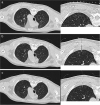Comparative study on preoperative localization techniques using microcoil and hookwire by propensity score matching
- PMID: 32207226
- PMCID: PMC7262885
- DOI: 10.1111/1759-7714.13365
Comparative study on preoperative localization techniques using microcoil and hookwire by propensity score matching
Abstract
Background: The purpose of this study was to compare the efficacy and safety of two preoperative pulmonary nodule localization techniques using microcoil and hookwire.
Methods: A total of 307 patients with 324 pulmonary nodules were included in the study from March 2012 to October 2016 in two medical centers. Baseline data, positioning operation data, success rate, complications, surgery and pathological results were statistically analyzed. Complications were used as the dependent variables, whereas others were used as covariates for the propensity score matching of the two groups. Statistical analyses were performed to compare the success rate and complication rate of the matched groups.
Results: There were 218 lesions in the microcoil group and 106 nodules in the hookwire group. There were no significant differences in gender, age and the location of nodules between the two groups. The diameters of the nodules were smaller (8.2 ± 3.5 mm vs. 10.7 ± 4.3 mm) and solid nodules were fewer (11.5% vs. 26.4%) in the microcoil group. The complication rate of the two groups was not statistically significant. After propensity score matching, 71 patients in each group were successfully matched. We found that the success rate was higher (97.2% vs. 94.4%) and the incidence of complications was lower (31% vs. 15.5%) in the microcoil group.
Conclusions: Both techniques have been shown to be effective in preoperative localization of tiny pulmonary nodules. The method of microcoil localization has more advantages in clinical application.
Key points: Comparison of the efficacy and safety of two methods in preoperative pulmonary nodule localization in order to determine the optimal method.
Keywords: Localization; lung cancer; nodule; thoracoscopic.
© 2020 The Authors. Thoracic Cancer published by China Lung Oncology Group and John Wiley & Sons Australia, Ltd.
Figures




References
-
- Naidich DP, Bankier AA, MacMahon H et al Recommendations for the management of subsolid pulmonary nodules detected at CT: A statement from the Fleischner society. Radiology 2013; 266 (1): 304–17. - PubMed
-
- Park CH, Han K, Hur J et al Comparative effectiveness and safety of pre‐operative lung localization for pulmonary nodules: A systematic review and meta‐analysis. Chest 2016; 151 (2): 316–28. - PubMed
-
- Ciriaco P, Negri G, Puglisi A, Nicoletti R, del Maschio A, Zannini P. Video‐assisted thoracoscopic surgery for pulmonary nodules: Rationale for preoperative computed tomography‐guided hookwire localization. Eur J Cardiothorac Surg 2004; 25 (3): 429–33. - PubMed
-
- Gonfiotti A, Davini F, Vaggelli L et al Thoracoscopic localization techniques for patients with solitary pulmonary nodule: Hookwire versus radio‐guided surgery. Eur J Cardiothorac Surg 2007; 32 (6): 843–7. - PubMed
Publication types
MeSH terms
LinkOut - more resources
Full Text Sources
Medical

